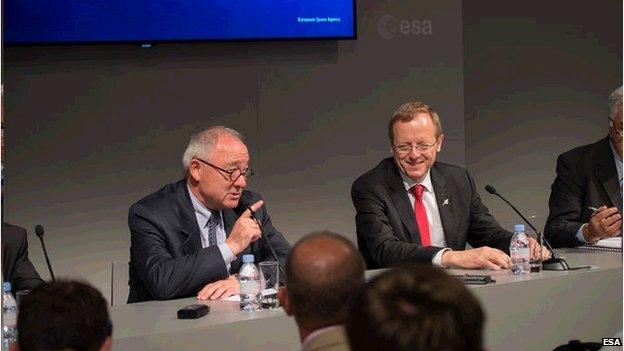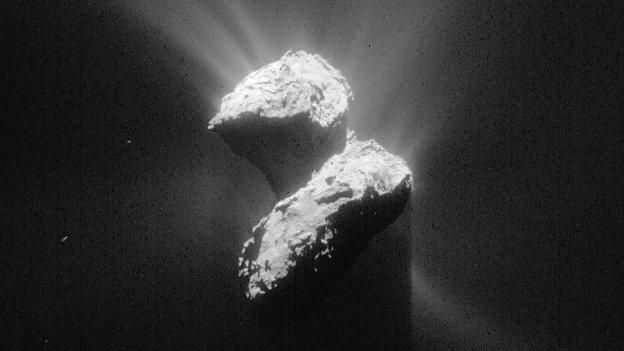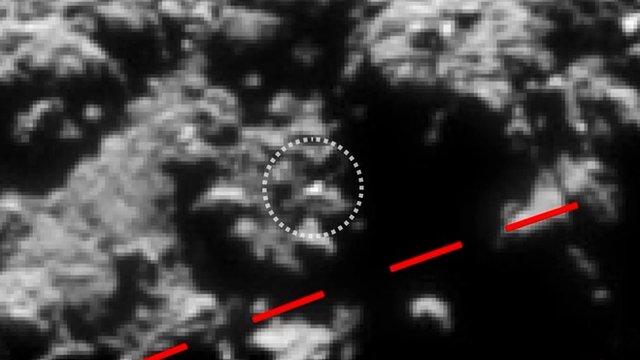Comet robot Philae phones home again
- Published
Jean-Jacques Dordain from the European Space Agency says the Philae probe is in good shape
Europe's comet lander has again been in touch with Earth.
The Philae probe made three short contacts of about 10 seconds each at roughly 2130 GMT on Sunday.
Controllers at the European Space Agency said the contacts were briefer than they had hoped, but proved the little robot was in encouragingly good health after its seven-month slumber.
Philae landed on Comet 67P in November and worked for 60 hours before its battery ran flat.
The robot awoke on Saturday because the comet has moved closer to the Sun, and its solar panels can now generate the electricity needed to power up its systems, including the transmitter.
Its mothership Rosetta, the craft that dropped it on to 67P, is still in orbit around the comet, and can relay messages to Earth.
"We had another contact on Sunday night," explained Paolo Ferri, the head of operations at Esa's mission control in Darmstadt Germany.
"That's good, obviously, but we're still trying to understand why these contacts are so short. Saturday's was only 85 seconds; these were 10 seconds in duration spread over several minutes.
"It could have something to do with the orientation of Rosetta; it may not be pointing in exactly the right direction.
"But Rosetta is also 200km from the comet, and although the link should be sufficient it is not super-strong, and if you don't have the correct alignment, you could lose the connection."
Speaking here at the Paris Airshow, Esa's soon-to-depart director general, Jean-Jacques Dordain, said the communications, however brief, should be taken as a positive.
"It means that we can have hope that we shall have more contact with Philae, and especially data," he told reporters.
And his replacement, Jan Woerner, who takes the Esa reins in July, said the revival of the robot further underlined the success of the comet mission.
"We will have now three hours of sunshine per day on Philae, and we will change the orbit of Rosetta in order to get a better connection, and we will start then with all the scientific work, with all the so-called non mechanical instruments."

Jean-Jacques Dordain and Jan Woerner discussed Philae at Le Bourget
Esa's science director, Alvaro Giménez, thought this could even begin within the week.
"The aim eventually is to charge the secondary battery so that we can work at any time, but to do that we would need to send commands. And before all that, we have to consolidate communication so that we can talk to Philae in the normal way."
The various science and engineering teams on the mission are now discussing how to improve the situation.
Moving Rosetta, while better for talking to Philae, may not be welcome among some scientists whose primary research is being done using the mothership. But Prof Giménez said there would need to be compromise.
There should be a further opportunity for contact with Philae on Monday and Tuesday as well. Rosetta experiences two possible communication slots per 24 hours - once per 12-hour comet rotation.
Currently, the comet, Philae and Rosetta are about 305 million km from Earth. Radio messages take 17 minutes to travel across this vast expanse of space.
Philae went into hibernation after bouncing into a dark ditch on landing.
The resting place had high walls that obscured the Sun, resulting in the robot's batteries flat-lining within three days.
With 67P sweeping in towards the Sun, these conditions have changed. Philae's solar panels are now getting longer and more intense exposure to the Sun.
Running surface experiments today would be even better than back in November.
That is because 67P is approaching perihelion - its closest point to our star.
The icy body is now throwing off copious amounts of gas and dust. If, as theory holds, comets are leftovers from the formation of the Solar System, then analysis of all this ejected material should yield remarkable insights into the initial conditions that gave rise to the planets.
You can watch The Sky At Night's Rosetta Update - A Comet's Story on Tuesday 16 June at 23:55 on BBC Four

As Comet 67P warms up its ices will melt, causing it to spew out gas and dust
- Published14 June 2015

- Published14 June 2015
- Published14 June 2015

- Published11 June 2015

- Published15 November 2014
- Published30 January 2015
